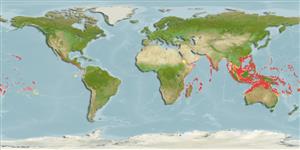Environment: milieu / climate zone / depth range / distribution range
Ecologia
marino; acqua dolce; salmastro demersale; catadromo (Ref. 51243); distribuzione batimetrica 1 - 400 m (Ref. 6898). Tropical; 31°N - 35°S, 21°E - 134°W
Indo-Pacific: East Africa, inland Mozambique and lower Zambezi River to French Polynesia, north to southern Japan (Ref. 7050). Also rivers of Madagascar and adjacent islands (Ref. 52193).
Size / Peso / Age
Maturity: Lm ? range ? - ? cm
Max length : 70.0 cm TL maschio/sesso non determinato; (Ref. 57749); 200.0 cm TL (female); common length : 26.3 cm TL maschio/sesso non determinato; (Ref. 35840); peso massimo pubblicato: 20.5 kg (Ref. 13337); peso massimo pubblicato: 20.5 kg; Età massima riportata: 40 anni (Ref. 48660)
Vertebre: 100 - 110. Diagnosis: Distinguished from all other species by the mottled colour and the long dorsal fin, which begins closer to the gill opening than to the anus (Ref. 9828).
Live in freshwater areas as adults, estuaries and seas as young (Ref. 12693). Found in lowland rivers as well as upland tributaries (Ref. 2847). While in river, the sex gland does not develop. But in winter when they move from the stream to river mouth, the sex gland begins to develop as mature individuals go to deep sea to breed (Ref. 45563). The spawning grounds are deep sea gullies among the south of the Philippines, east of Indonesia and Papua New Guinea (Ref. 45563). Are active at night, feeding on a wide range of prey (Ref. 7248, 79840), especially crabs, frogs and fish (Ref. 7248). Thought to breed east of Madagascar where the young are wafted to the East Coast by ocean currents (Ref. 13337, 79840).
Life cycle and mating behavior
Maturità | Riproduzione | Deposizione | Uova | Fecundity | Larve
Castle, P.H.J., 1984. Anguillidae. p. 34-37. In J. Daget, J.-P. Gosse and D.F.E. Thys van den Audenaerde (eds.) Check-list of the freshwater fishes of Africa (CLOFFA). ORSTOM, Paris and MRAC, Tervuren. Vol. 1. (Ref. 3506)
IUCN Red List Status (Ref. 130435)
Threat to humans
Harmless
Human uses
Pesca: commerciale; Acquacoltura: commerciale; Pesce da pesca sportiva: si
Informazioni ulteriori
Nomi ComuniSinonimiMetabolismoPredatoriEcotossicologiaRiproduzioneMaturitàDeposizioneSpawning aggregationFecundityUovaEgg development
BibliografiaAcquacolturaProfilo di acquacolturaVarietàGeneticaElectrophoresesEreditarietàMalattieElaborazioneNutrientsMass conversion
Strumenti
Special reports
Download XML
Fonti Internet
Estimates based on models
Preferred temperature (Ref.
123201): 15.7 - 27.8, mean 24.5 °C (based on 725 cells).
Phylogenetic diversity index (Ref.
82804): PD
50 = 0.5000 [Uniqueness, from 0.5 = low to 2.0 = high].
Bayesian length-weight: a=0.00076 (0.00037 - 0.00155), b=3.17 (3.00 - 3.34), in cm total length, based on LWR estimates for this Genus-body shape (Ref.
93245).
Trophic level (Ref.
69278): 3.8 ±0.67 se; based on food items.
Resilienza (Ref.
120179): Molto basso, tempo minimo di raddoppiamento della popolazione più di 14 anni (tmax=40).
Fishing Vulnerability (Ref.
59153): Very high vulnerability (90 of 100).
